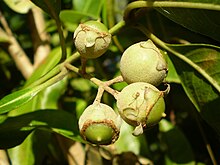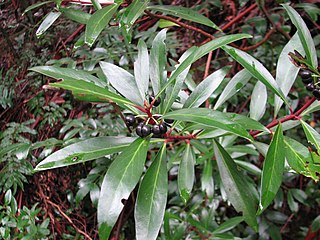
Tasmannia lanceolata, commonly known as Tasmanian pepperberry, mountain pepper (Aus), or Cornish pepper leaf (UK), is a shrub native to woodlands and cool temperate rainforest of south-eastern Australia. The shrub varies from 2 to 10 m high. The aromatic leaves are lanceolate to narrow-elliptic or oblanceolate, 4–12 cm long, and 0.7–2.0 cm wide, with a distinctly pale undersurface. Stems are quite red in colour. The small cream or white flowers appear in summer and are followed by black, globose, two-lobed berries 5–8 mm wide, which appear in autumn. There are separate male and female plants.
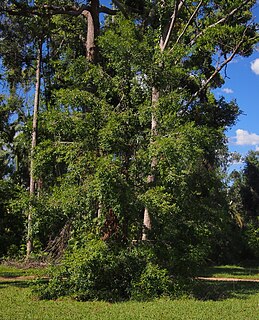
Podocarpus elatus, known as the plum pine, the brown pine or the Illawarra plum is a species of Podocarpus endemic to the east coast of Australia, in eastern New South Wales and eastern Queensland.

Syzygium luehmannii is a medium-sized coastal rainforest tree native to Australia. Common names include riberry, small leaved lilly pilly, cherry satinash, cherry alder, or clove lilli pilli.

Eupomatia laurina, commonly named bolwarra or sometimes native guava or copper laurel, is a species of shrubs to small trees, of the Australian continent ancient plant family Eupomatiaceae. They often grow between 3 and 5 m tall, larger specimens may attain 15 m (50 ft) and a trunk diameter of 30 cm (12 in). They grow naturally in eastern Australia and New Guinea. In Australia, they grow as far south as Nowa Nowa in the humid forests of the warm temperate east of the state of Victoria through eastern New South Wales and Queensland north to tropical Cape York Peninsula. They are one of the ancient lineages of flowering plants, usually growing as part of an understorey in rainforests or humid Eucalypt forests.

Eucryphia moorei, commonly known as pinkwood, plumwood, or eastern leatherwood is a tree found in southeastern New South Wales, Australia. It also occurs just over the border at the Howe Range in Victoria. Pinkwood is the dominant tree species of cool-temperate rainforests of southeastern NSW. Young plants often grow as hemiepiphytes.

Cryptocarya rigida is a small tree or shrub growing in high rainfall areas in north eastern New South Wales, Australia. It was described in 1864 by Carl Meissner in Prodromus Systematis Naturalis Regni Vegetabilis. Extinct in the Illawarra region, allegedly seen in the Illawarra in 1818 by Allan Cunningham.
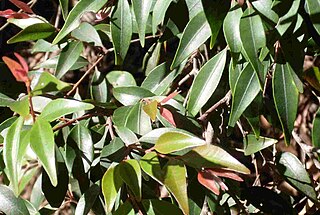
Uromyrtus australis, commonly known as the peach myrtle, is a small tree growing around Nightcap National Park, New South Wales, Australia. It is endangered by extinction. The delicate foliage, pink flowers and appealing fruit makes this a particularly beautiful tree.
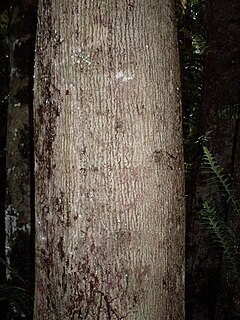
Emmenosperma alphitonioides known as the Yellow Ash or Bonewood is a rainforest tree of eastern Australia. It grows from Clyde River, New South Wales near Batemans Bay, to Cape York Peninsula in at the most northerly part of Australia. It grows in many different types of rainforest, in tropical, sub tropical and warm temperate rainforests.

Elaeocarpus holopetalus is a small rainforest tree of eastern Australia. It grows from near the Snowy River (37°S) to Chaelundi National Park (29°S) in northern New South Wales. It grows at high altitude in gullies.

Cymbidium madidum, commonly known as the giant boat-lip orchid, is a plant in the orchid family and is endemic to north-eastern Australia. It is a clump-forming epiphyte or lithophyte with crowded pseudobulbs, each with between four and eight flat, strap-shaped, thin leaves and up to seventy olive green flowers with the sepals and petals curving forwards. It is found in moist habitats in eastern Queensland and north-eastern New South Wales.

Cymbidium canaliculatum, commonly known as the channelled boat-lip orchid, tiger boat-lip orchid, native cymbidium or tiger orchid is a plant in the orchid family and is endemic to Australia. It is a clump-forming epiphyte with large, greyish green pseudobulbs, each with up to six curved, deeply channelled leaves and up to sixty fragrant, variably coloured flowers that often have spots and blotches and a white to cream-coloured labellum with red markings. This orchid usually grows in the forks or hollows of trees and is found from New South Wales to the northern parts of Western Australia.

Waterhousea floribunda is a rainforest tree of eastern Australia. It grows along streams from the Williams River near Dungog to Mackay in central eastern Queensland. Known as the weeping lilli pilli, this tree is widely planted as an ornamental. Planted trees from 1827 may be seen at the Royal Botanic Gardens, Sydney. However, these trees are damaged and threatened by the roosting grey headed flying foxes. A very large tree is located at Western Park in Auckland, New Zealand.

Diospyros australis is the most southerly of the group of some 450 ebonies and persimmons. It is a shrub or small tree growing in rainforests of seaward eastern Australia. The habitat is in a variety of different rainforest forms, though not often seen in the cool temperate rainforests. The range of natural distribution is from Durras Lake near Batemans Bay in south east New South Wales, to Atherton in tropical Queensland.

Endiandra discolor is an Australian tree, growing from near Gosford, New South Wales to Tully, Queensland in the tropics. Common names include rose walnut and domatia tree.

Gossia acmenoides, known as the scrub ironwood, is a rainforest tree of the family Myrtaceae, native to eastern Australia. The usual habitat of this small tree is drier rainforest areas. The range of natural distribution is from Jamberoo in New South Wales to Eungella National Park in northern Queensland.
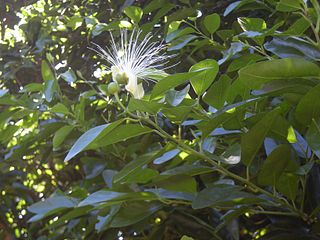
Capparis arborea is a bush or small tree occurring in eastern Australia. The habitat is rainforest; usually riverine, littoral or the drier rainforests. Distributed from the Hunter River, New South Wales to Cape Melville in tropical Queensland. Common names include native pomegranate, wild lime, wild lemon and brush caper berry.

Planchonella queenslandica, the blush condoo, is a large rainforest tree of the Sapotaceae family native to eastern Australia. It's found in sea side rainforest as well as the drier inland rainforests. From as far south as the Richmond River, New South Wales to Coen in tropical Queensland, and as far west as Melville Island, Northern Territory.

Uromyrtus lamingtonensis is a rare Australian shrub growing around the state border of New South Wales and Queensland. Like the Peach Myrtle, it has attractive pink flowers.

Vesselowskya rubifolia is a rainforest plant of restricted distribution from eastern New South Wales, Australia. The common name is mountain marara or Dorrigo southern marara. The species name rubifolia is from the Latin, meaning "bramble". The leaves resemble the blackberry. The genus is named after the Russian botanist E. Vesselowsky.
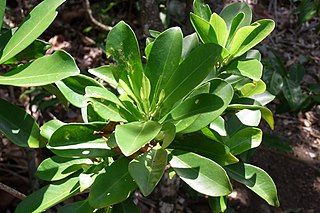
Halfordia kendack is a rainforest tree in the citrus family, found in eastern Australia. Common names include saffronheart, kerosenewood and southern ghittoe. The natural distribution is from Woolgoolga in New South Wales to many parts of coastal Queensland, Torres Strait and also New Caledonia.
